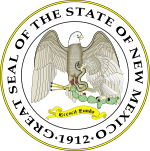
The Institutional Revolutionary Party is a political party in Mexico that was founded in 1929 and held uninterrupted power in the country for 71 years, from 1929 to 2000, first as the National Revolutionary Party, then as the Party of the Mexican Revolution and finally as the PRI beginning in 1946.
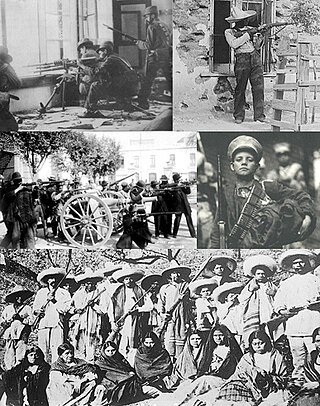
The Mexican Revolution was an extended sequence of armed regional conflicts in Mexico from 20 November 1910 to 1 December 1920. It has been called "the defining event of modern Mexican history" and resulted in the destruction of the Federal Army, its replacement by a revolutionary army, and the transformation of Mexican culture and government. The northern Constitutionalist faction prevailed on the battlefield and drafted the present-day Constitution of Mexico, which aimed to create a strong central government. Revolutionary generals held power from 1920 to 1940. The revolutionary conflict was primarily a civil war, but foreign powers, having important economic and strategic interests in Mexico, figured in the outcome of Mexico's power struggles; the U.S. involvement was particularly high. The conflict led to the deaths of around one million people, mostly noncombatants.
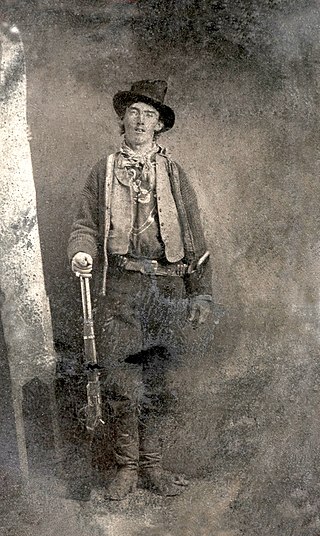
Henry McCarty, alias William H. Bonney, better known as Billy the Kid, was an American outlaw and gunfighter of the Old West who is alleged to have killed 21 men before he was shot and killed at the age of 21. He is also known for his involvement in New Mexico's Lincoln County War, during which he allegedly committed three murders.
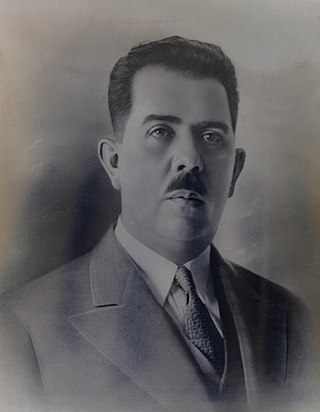
Lázaro Cárdenas del Río was a Mexican army officer and politician who served as president of Mexico from 1934 to 1940. Previously, he served as a general in the Constitutional Army during the Mexican Revolution and as Governor of Michoacán and President of the Institutional Revolutionary Party. He later served as the Secretary of National Defence. During his presidency, which is considered the end of the Maximato, he implemented massive land reform programs, led the expropriation of the country's oil industry, and implemented many left-leaning reforms.

Plutarco Elías Calles was a Mexican soldier and politician who served as President of Mexico from 1924 to 1928. After the assassination of Álvaro Obregón, Elías Calles founded the Institutional Revolutionary Party and held unofficial power as Mexico's de facto leader from 1929 to 1934, a period known as the Maximato. Previously, he served as a general in the Constitutional Army, as Governor of Sonora, Secretary of War, and Secretary of the Interior. During the Maximato, he served as Secretariat of Public Education, Secretary of War again, and Secretary of the Economy. During his presidency, he implemented many left-wing populist and secularist reforms, opposition to which sparked the Cristero War.

Miguel Alemán Valdés was a Mexican politician who served a full term as the President of Mexico from 1946 to 1952, the first civilian president after a string of revolutionary generals.

The governors of the Mexican state of Quintana Roo, since statehood.

Oscar Branch Colquitt was the 25th Governor of Texas from January 17, 1911, to January 19, 1915. He was a member of the Democratic Party. Gov. Colquitt defended the actions of the Texas Rangers who allegedly crossed into Mexico in pursuit of the body of Clemente Vergara in March 1914.

Joseph Manuel Montoya was an American politician and member of the Democratic Party who served as the lieutenant governor of New Mexico, in the U.S. House of Representatives (1957–1964) and as a U.S. senator from New Mexico (1964–1977).

Roberto A. Mondragón is an American politician, musician, and activist. He was the Green Party nominee for governor of New Mexico in 1994, receiving 10.4% of the vote, and coming third, behind winner Gary Johnson and incumbent Democratic candidate Bruce King. Prior to this, he served as lieutenant governor of New Mexico from 1971 to 1975 and from 1979 to 1983, and as a state representative. He currently serves as special water projects coordinator for the New Mexico state engineer's office and the Interstate Stream Commission. Mondragón later returned to the Democratic Party.

The New Mexico National Guard is the militia of the U.S. state of New Mexico. Comprising the New Mexico Army National Guard and the New Mexico Air National Guard, it is part of the National Guard of the United States, a reserve force under both state and federal jurisdiction.

The governor of Oaxaca, who as of 2020 is Alejandro Murat Hinojosa, heads the executive branch of the Mexican state of Oaxaca. The office is created by the state constitution, which specifies a term of 6 years and prohibits reelection. The governor takes office on December 1, and the term ends on November 30 six years later.

Gustavo Baz Prada was a Mexican politician and medical doctor. He was Governor of the State of Mexico from 1914 to 1915 and from 1957 to 1963.

John Field Simms Jr. was an American politician and lawyer from the state of New Mexico who served as the 16th Governor of New Mexico.

The governor of Zacatecas wields executive power in the State of Zacatecas. The governor is directly elected by the citizens, using secret ballot, to a six-year term with no possibility of reelection.

John Joseph Dempsey was an American politician and United States Representative from New Mexico who also served as the 13th governor of New Mexico. He was born in White Haven, Pennsylvania, where he attended grade school. Employed as a telegrapher, he held various positions with the Brooklyn Union Elevator Company. He was the vice president of the Brooklyn Rapid Transit Company until 1919 when he entered the oil business in Oklahoma and became vice president of the Continental Oil and Asphalt Company. He moved to Santa Fe, New Mexico, in 1920 and was an independent oil operator and in 1928 became president of the United States Asphalt Company.

John Moren Campbell was an American politician who served as the 21st governor of New Mexico from January 1, 1963 until January 1, 1967.
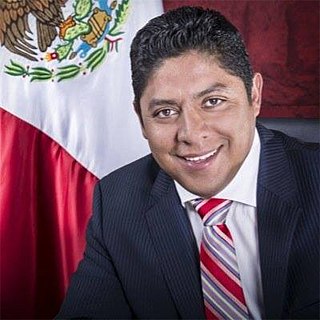
The governor of San Luis Potosí exercises the role of the executive branch of government in the Mexican state of San Luis Potosí, per the Political Constitution of the Free and Sovereign State of San Luis Potosí. The official title is Gobernador Constitucional del Estado Libre y Soberano de San Luis Potosí.

Michelle Lujan Grisham is an American lawyer and politician serving since 2019 as the 32nd governor of New Mexico. A member of the Democratic Party, Lujan Grisham previously served as the U.S. representative for New Mexico's 1st congressional district from 2013 to 2019.
James Brooks Jones, nicknamed "Jawbone", was an American politician from the US state of New Mexico. He served as the lieutenant governor of New Mexico from January 1, 1943, to January 1, 1947.

